Strategic Marketing for Desklib: Analysis, Evaluation and Approaches
VerifiedAdded on 2023/06/18
|15
|4045
|201
AI Summary
This report provides an analysis and evaluation of the strategic marketing context for Desklib, an online library for study material. It explores key contextual factors, critical strategic collaboration, company analysis and evaluation, marketing resources and capabilities, competitive advantage and positioning. The report also determines and evaluates critical strategic marketing approaches, including value-driven strategy and innovation strategies.
Contribute Materials
Your contribution can guide someone’s learning journey. Share your
documents today.
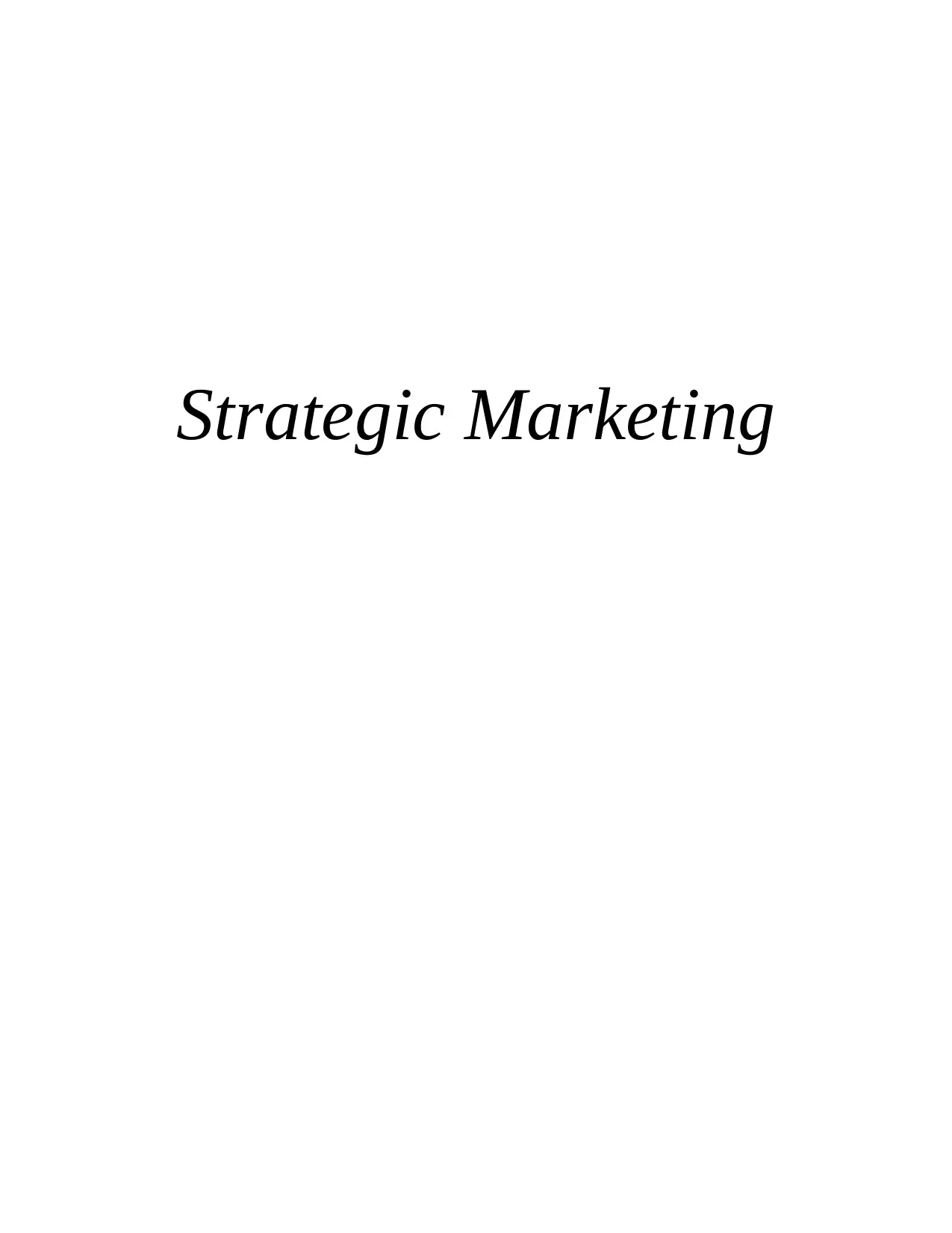
Strategic Marketing
Secure Best Marks with AI Grader
Need help grading? Try our AI Grader for instant feedback on your assignments.
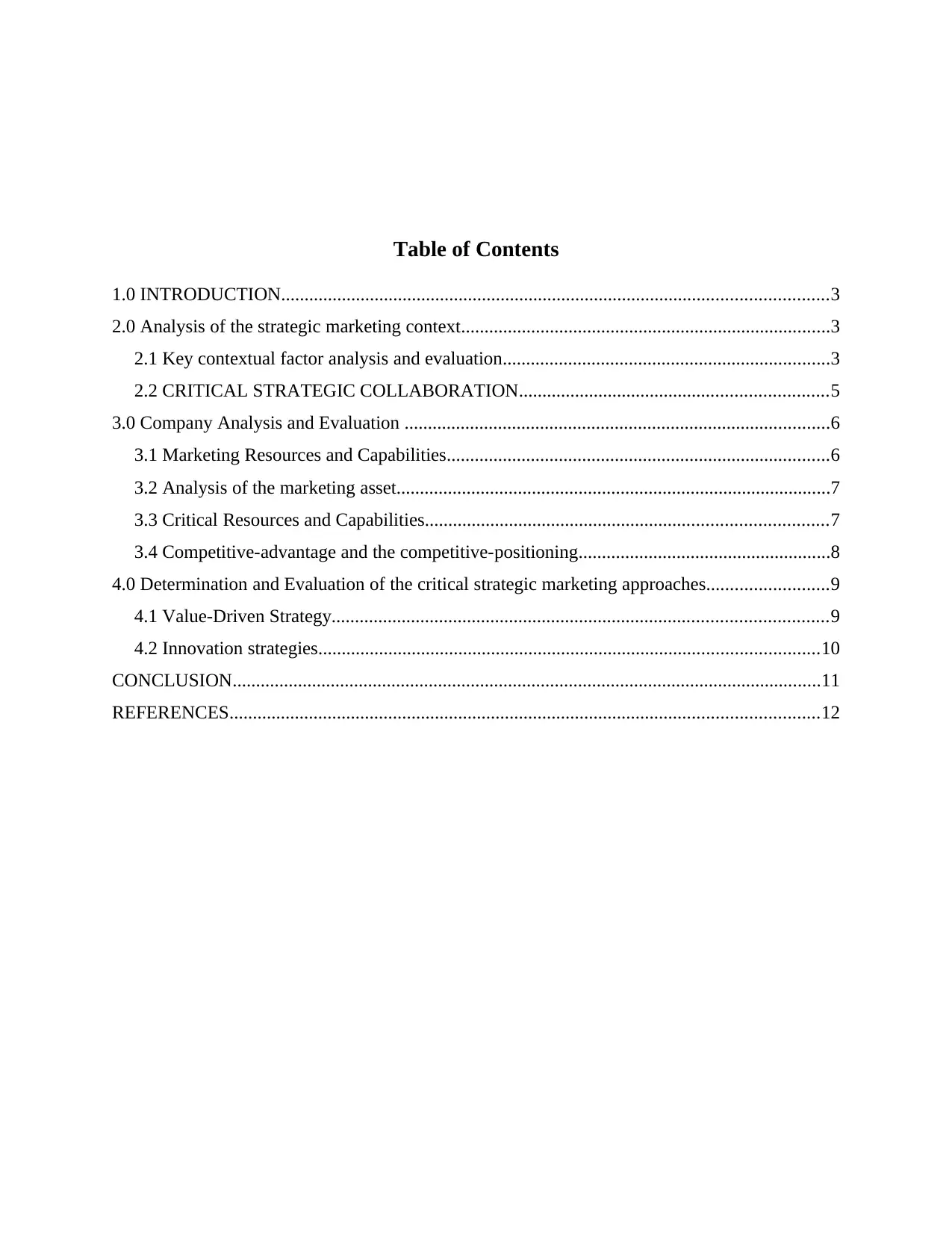
Table of Contents
1.0 INTRODUCTION.....................................................................................................................3
2.0 Analysis of the strategic marketing context...............................................................................3
2.1 Key contextual factor analysis and evaluation......................................................................3
2.2 CRITICAL STRATEGIC COLLABORATION..................................................................5
3.0 Company Analysis and Evaluation ...........................................................................................6
3.1 Marketing Resources and Capabilities..................................................................................6
3.2 Analysis of the marketing asset.............................................................................................7
3.3 Critical Resources and Capabilities......................................................................................7
3.4 Competitive-advantage and the competitive-positioning......................................................8
4.0 Determination and Evaluation of the critical strategic marketing approaches..........................9
4.1 Value-Driven Strategy..........................................................................................................9
4.2 Innovation strategies...........................................................................................................10
CONCLUSION..............................................................................................................................11
REFERENCES..............................................................................................................................12
1.0 INTRODUCTION.....................................................................................................................3
2.0 Analysis of the strategic marketing context...............................................................................3
2.1 Key contextual factor analysis and evaluation......................................................................3
2.2 CRITICAL STRATEGIC COLLABORATION..................................................................5
3.0 Company Analysis and Evaluation ...........................................................................................6
3.1 Marketing Resources and Capabilities..................................................................................6
3.2 Analysis of the marketing asset.............................................................................................7
3.3 Critical Resources and Capabilities......................................................................................7
3.4 Competitive-advantage and the competitive-positioning......................................................8
4.0 Determination and Evaluation of the critical strategic marketing approaches..........................9
4.1 Value-Driven Strategy..........................................................................................................9
4.2 Innovation strategies...........................................................................................................10
CONCLUSION..............................................................................................................................11
REFERENCES..............................................................................................................................12
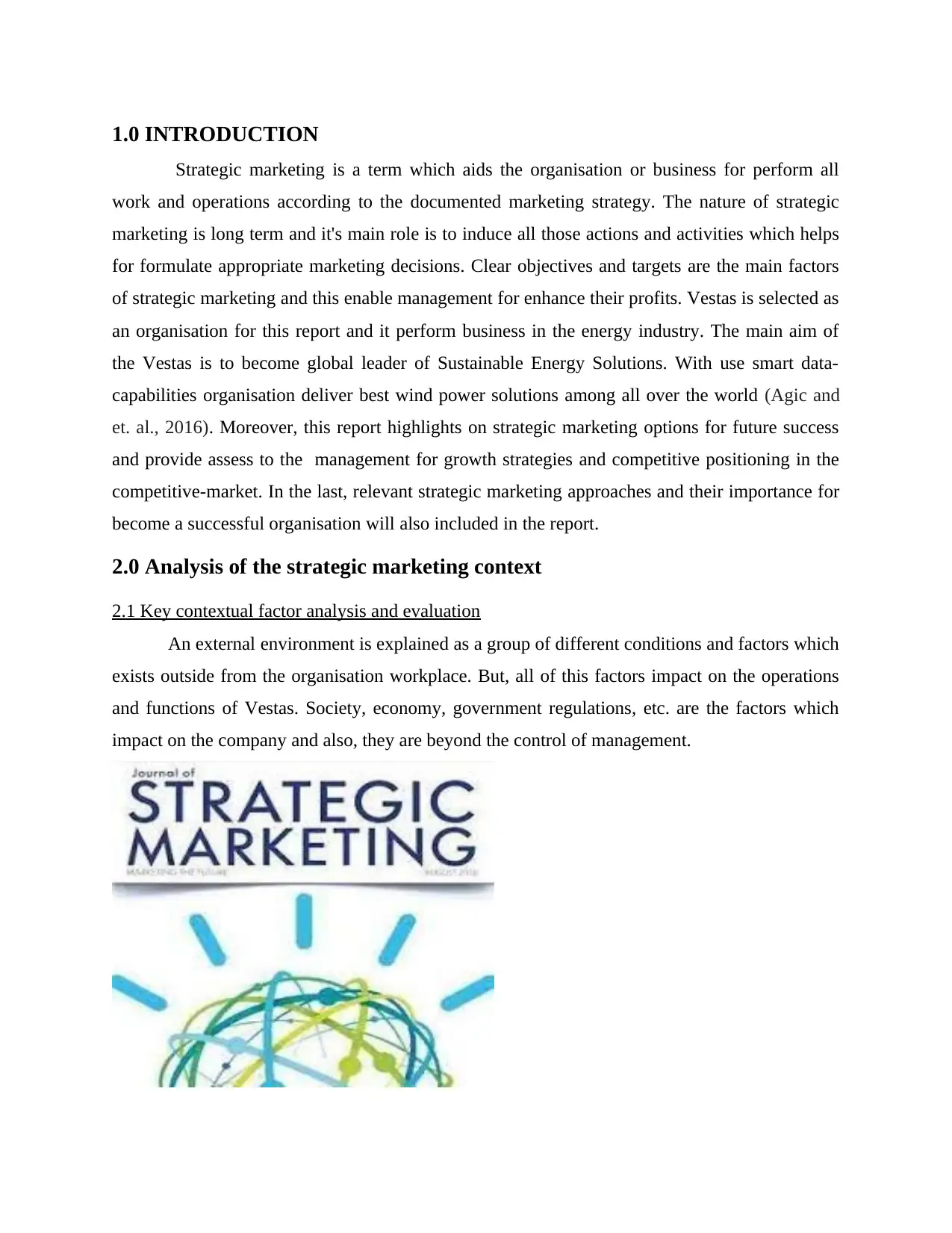
1.0 INTRODUCTION
Strategic marketing is a term which aids the organisation or business for perform all
work and operations according to the documented marketing strategy. The nature of strategic
marketing is long term and it's main role is to induce all those actions and activities which helps
for formulate appropriate marketing decisions. Clear objectives and targets are the main factors
of strategic marketing and this enable management for enhance their profits. Vestas is selected as
an organisation for this report and it perform business in the energy industry. The main aim of
the Vestas is to become global leader of Sustainable Energy Solutions. With use smart data-
capabilities organisation deliver best wind power solutions among all over the world (Agic and
et. al., 2016). Moreover, this report highlights on strategic marketing options for future success
and provide assess to the management for growth strategies and competitive positioning in the
competitive-market. In the last, relevant strategic marketing approaches and their importance for
become a successful organisation will also included in the report.
2.0 Analysis of the strategic marketing context
2.1 Key contextual factor analysis and evaluation
An external environment is explained as a group of different conditions and factors which
exists outside from the organisation workplace. But, all of this factors impact on the operations
and functions of Vestas. Society, economy, government regulations, etc. are the factors which
impact on the company and also, they are beyond the control of management.
Strategic marketing is a term which aids the organisation or business for perform all
work and operations according to the documented marketing strategy. The nature of strategic
marketing is long term and it's main role is to induce all those actions and activities which helps
for formulate appropriate marketing decisions. Clear objectives and targets are the main factors
of strategic marketing and this enable management for enhance their profits. Vestas is selected as
an organisation for this report and it perform business in the energy industry. The main aim of
the Vestas is to become global leader of Sustainable Energy Solutions. With use smart data-
capabilities organisation deliver best wind power solutions among all over the world (Agic and
et. al., 2016). Moreover, this report highlights on strategic marketing options for future success
and provide assess to the management for growth strategies and competitive positioning in the
competitive-market. In the last, relevant strategic marketing approaches and their importance for
become a successful organisation will also included in the report.
2.0 Analysis of the strategic marketing context
2.1 Key contextual factor analysis and evaluation
An external environment is explained as a group of different conditions and factors which
exists outside from the organisation workplace. But, all of this factors impact on the operations
and functions of Vestas. Society, economy, government regulations, etc. are the factors which
impact on the company and also, they are beyond the control of management.
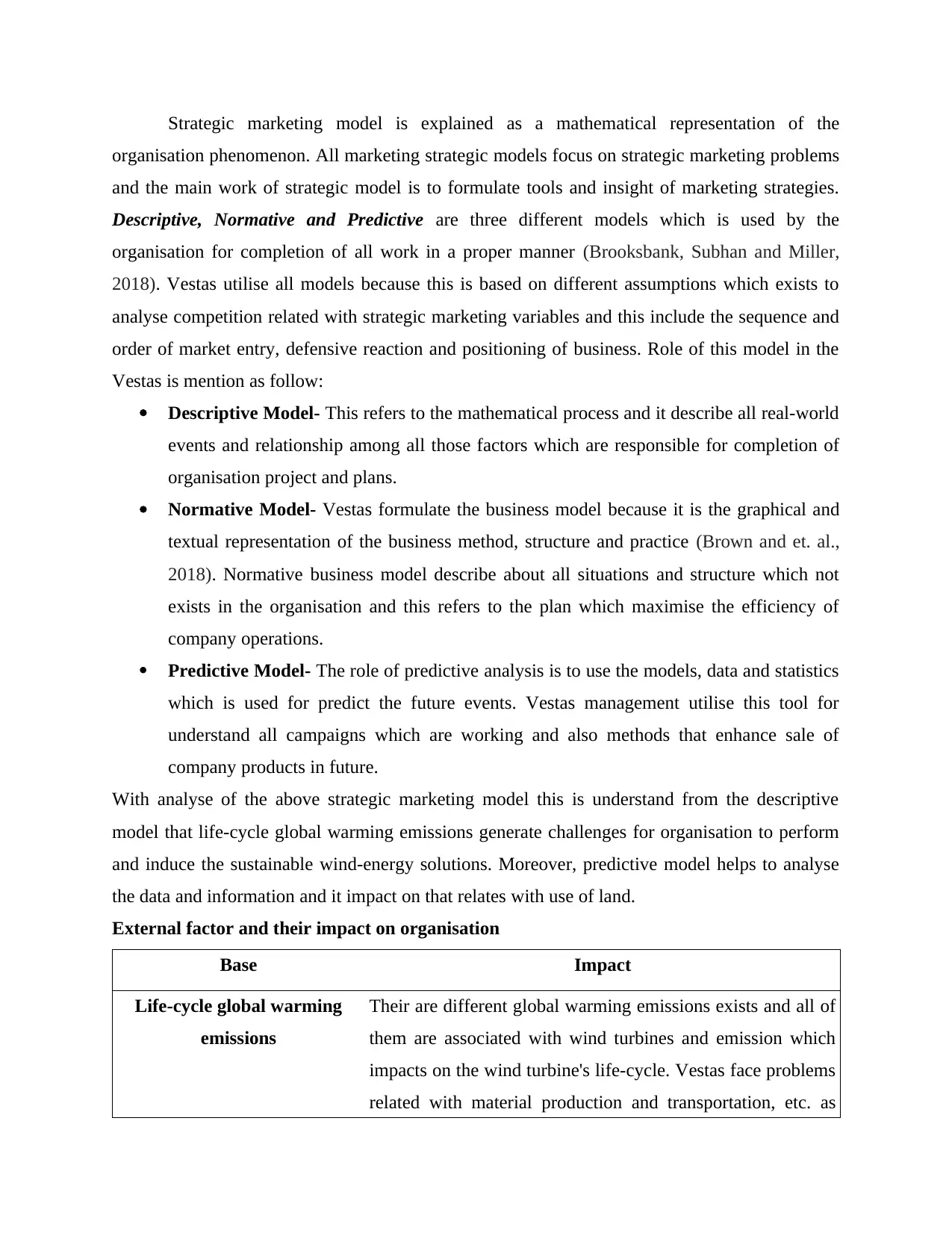
Strategic marketing model is explained as a mathematical representation of the
organisation phenomenon. All marketing strategic models focus on strategic marketing problems
and the main work of strategic model is to formulate tools and insight of marketing strategies.
Descriptive, Normative and Predictive are three different models which is used by the
organisation for completion of all work in a proper manner (Brooksbank, Subhan and Miller,
2018). Vestas utilise all models because this is based on different assumptions which exists to
analyse competition related with strategic marketing variables and this include the sequence and
order of market entry, defensive reaction and positioning of business. Role of this model in the
Vestas is mention as follow:
Descriptive Model- This refers to the mathematical process and it describe all real-world
events and relationship among all those factors which are responsible for completion of
organisation project and plans.
Normative Model- Vestas formulate the business model because it is the graphical and
textual representation of the business method, structure and practice (Brown and et. al.,
2018). Normative business model describe about all situations and structure which not
exists in the organisation and this refers to the plan which maximise the efficiency of
company operations.
Predictive Model- The role of predictive analysis is to use the models, data and statistics
which is used for predict the future events. Vestas management utilise this tool for
understand all campaigns which are working and also methods that enhance sale of
company products in future.
With analyse of the above strategic marketing model this is understand from the descriptive
model that life-cycle global warming emissions generate challenges for organisation to perform
and induce the sustainable wind-energy solutions. Moreover, predictive model helps to analyse
the data and information and it impact on that relates with use of land.
External factor and their impact on organisation
Base Impact
Life-cycle global warming
emissions
Their are different global warming emissions exists and all of
them are associated with wind turbines and emission which
impacts on the wind turbine's life-cycle. Vestas face problems
related with material production and transportation, etc. as
organisation phenomenon. All marketing strategic models focus on strategic marketing problems
and the main work of strategic model is to formulate tools and insight of marketing strategies.
Descriptive, Normative and Predictive are three different models which is used by the
organisation for completion of all work in a proper manner (Brooksbank, Subhan and Miller,
2018). Vestas utilise all models because this is based on different assumptions which exists to
analyse competition related with strategic marketing variables and this include the sequence and
order of market entry, defensive reaction and positioning of business. Role of this model in the
Vestas is mention as follow:
Descriptive Model- This refers to the mathematical process and it describe all real-world
events and relationship among all those factors which are responsible for completion of
organisation project and plans.
Normative Model- Vestas formulate the business model because it is the graphical and
textual representation of the business method, structure and practice (Brown and et. al.,
2018). Normative business model describe about all situations and structure which not
exists in the organisation and this refers to the plan which maximise the efficiency of
company operations.
Predictive Model- The role of predictive analysis is to use the models, data and statistics
which is used for predict the future events. Vestas management utilise this tool for
understand all campaigns which are working and also methods that enhance sale of
company products in future.
With analyse of the above strategic marketing model this is understand from the descriptive
model that life-cycle global warming emissions generate challenges for organisation to perform
and induce the sustainable wind-energy solutions. Moreover, predictive model helps to analyse
the data and information and it impact on that relates with use of land.
External factor and their impact on organisation
Base Impact
Life-cycle global warming
emissions
Their are different global warming emissions exists and all of
them are associated with wind turbines and emission which
impacts on the wind turbine's life-cycle. Vestas face problems
related with material production and transportation, etc. as
Secure Best Marks with AI Grader
Need help grading? Try our AI Grader for instant feedback on your assignments.
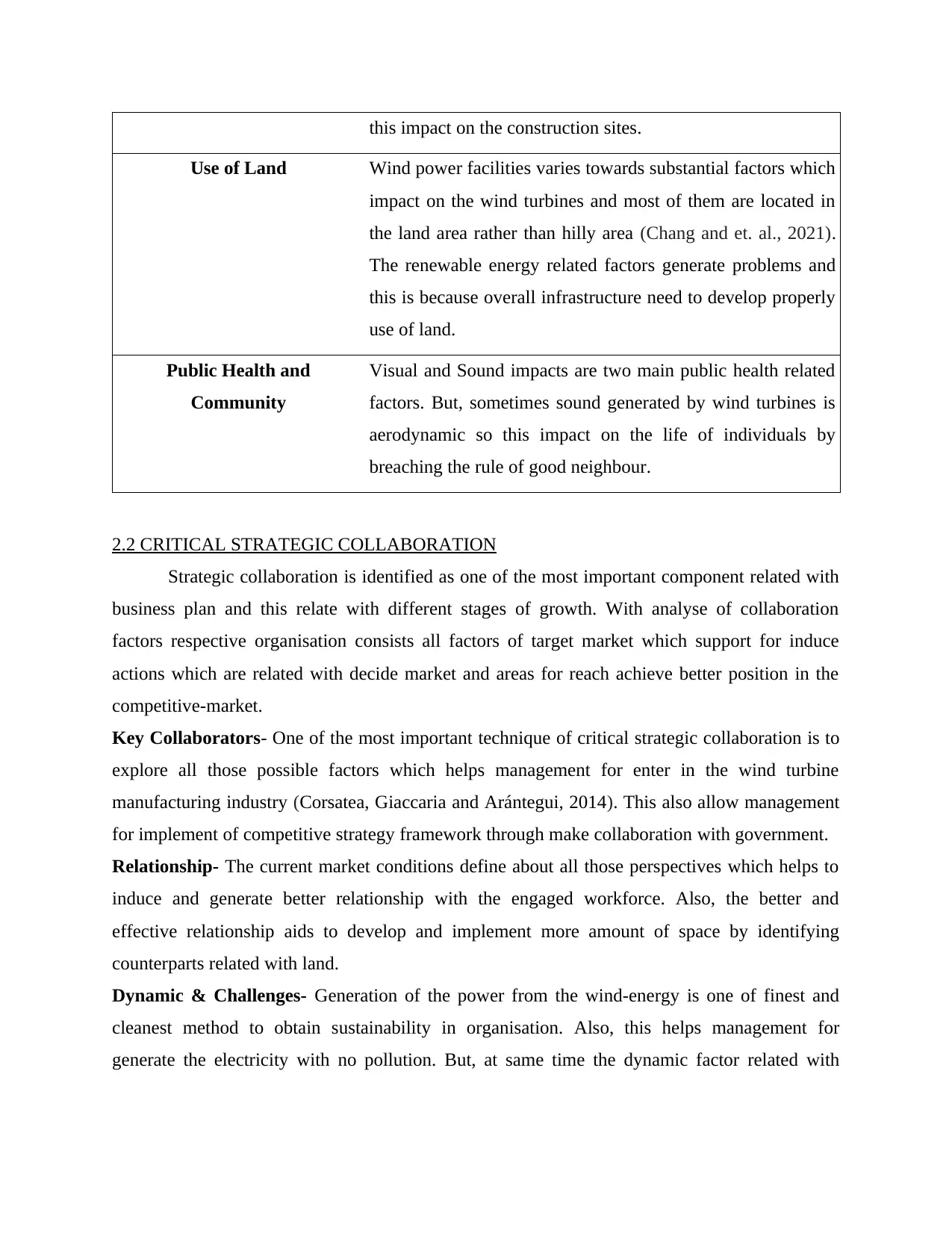
this impact on the construction sites.
Use of Land Wind power facilities varies towards substantial factors which
impact on the wind turbines and most of them are located in
the land area rather than hilly area (Chang and et. al., 2021).
The renewable energy related factors generate problems and
this is because overall infrastructure need to develop properly
use of land.
Public Health and
Community
Visual and Sound impacts are two main public health related
factors. But, sometimes sound generated by wind turbines is
aerodynamic so this impact on the life of individuals by
breaching the rule of good neighbour.
2.2 CRITICAL STRATEGIC COLLABORATION
Strategic collaboration is identified as one of the most important component related with
business plan and this relate with different stages of growth. With analyse of collaboration
factors respective organisation consists all factors of target market which support for induce
actions which are related with decide market and areas for reach achieve better position in the
competitive-market.
Key Collaborators- One of the most important technique of critical strategic collaboration is to
explore all those possible factors which helps management for enter in the wind turbine
manufacturing industry (Corsatea, Giaccaria and Arántegui, 2014). This also allow management
for implement of competitive strategy framework through make collaboration with government.
Relationship- The current market conditions define about all those perspectives which helps to
induce and generate better relationship with the engaged workforce. Also, the better and
effective relationship aids to develop and implement more amount of space by identifying
counterparts related with land.
Dynamic & Challenges- Generation of the power from the wind-energy is one of finest and
cleanest method to obtain sustainability in organisation. Also, this helps management for
generate the electricity with no pollution. But, at same time the dynamic factor related with
Use of Land Wind power facilities varies towards substantial factors which
impact on the wind turbines and most of them are located in
the land area rather than hilly area (Chang and et. al., 2021).
The renewable energy related factors generate problems and
this is because overall infrastructure need to develop properly
use of land.
Public Health and
Community
Visual and Sound impacts are two main public health related
factors. But, sometimes sound generated by wind turbines is
aerodynamic so this impact on the life of individuals by
breaching the rule of good neighbour.
2.2 CRITICAL STRATEGIC COLLABORATION
Strategic collaboration is identified as one of the most important component related with
business plan and this relate with different stages of growth. With analyse of collaboration
factors respective organisation consists all factors of target market which support for induce
actions which are related with decide market and areas for reach achieve better position in the
competitive-market.
Key Collaborators- One of the most important technique of critical strategic collaboration is to
explore all those possible factors which helps management for enter in the wind turbine
manufacturing industry (Corsatea, Giaccaria and Arántegui, 2014). This also allow management
for implement of competitive strategy framework through make collaboration with government.
Relationship- The current market conditions define about all those perspectives which helps to
induce and generate better relationship with the engaged workforce. Also, the better and
effective relationship aids to develop and implement more amount of space by identifying
counterparts related with land.
Dynamic & Challenges- Generation of the power from the wind-energy is one of finest and
cleanest method to obtain sustainability in organisation. Also, this helps management for
generate the electricity with no pollution. But, at same time the dynamic factor related with
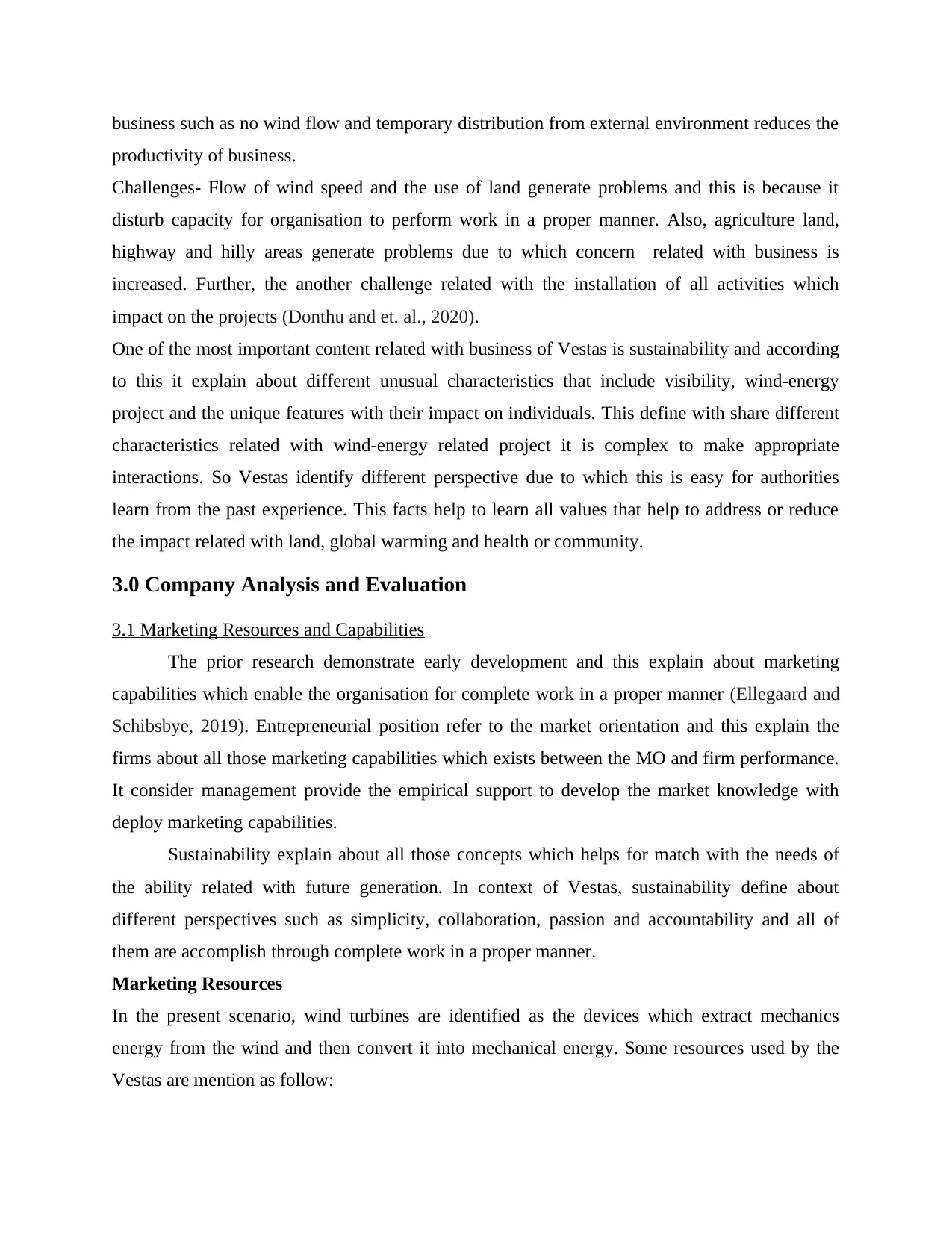
business such as no wind flow and temporary distribution from external environment reduces the
productivity of business.
Challenges- Flow of wind speed and the use of land generate problems and this is because it
disturb capacity for organisation to perform work in a proper manner. Also, agriculture land,
highway and hilly areas generate problems due to which concern related with business is
increased. Further, the another challenge related with the installation of all activities which
impact on the projects (Donthu and et. al., 2020).
One of the most important content related with business of Vestas is sustainability and according
to this it explain about different unusual characteristics that include visibility, wind-energy
project and the unique features with their impact on individuals. This define with share different
characteristics related with wind-energy related project it is complex to make appropriate
interactions. So Vestas identify different perspective due to which this is easy for authorities
learn from the past experience. This facts help to learn all values that help to address or reduce
the impact related with land, global warming and health or community.
3.0 Company Analysis and Evaluation
3.1 Marketing Resources and Capabilities
The prior research demonstrate early development and this explain about marketing
capabilities which enable the organisation for complete work in a proper manner (Ellegaard and
Schibsbye, 2019). Entrepreneurial position refer to the market orientation and this explain the
firms about all those marketing capabilities which exists between the MO and firm performance.
It consider management provide the empirical support to develop the market knowledge with
deploy marketing capabilities.
Sustainability explain about all those concepts which helps for match with the needs of
the ability related with future generation. In context of Vestas, sustainability define about
different perspectives such as simplicity, collaboration, passion and accountability and all of
them are accomplish through complete work in a proper manner.
Marketing Resources
In the present scenario, wind turbines are identified as the devices which extract mechanics
energy from the wind and then convert it into mechanical energy. Some resources used by the
Vestas are mention as follow:
productivity of business.
Challenges- Flow of wind speed and the use of land generate problems and this is because it
disturb capacity for organisation to perform work in a proper manner. Also, agriculture land,
highway and hilly areas generate problems due to which concern related with business is
increased. Further, the another challenge related with the installation of all activities which
impact on the projects (Donthu and et. al., 2020).
One of the most important content related with business of Vestas is sustainability and according
to this it explain about different unusual characteristics that include visibility, wind-energy
project and the unique features with their impact on individuals. This define with share different
characteristics related with wind-energy related project it is complex to make appropriate
interactions. So Vestas identify different perspective due to which this is easy for authorities
learn from the past experience. This facts help to learn all values that help to address or reduce
the impact related with land, global warming and health or community.
3.0 Company Analysis and Evaluation
3.1 Marketing Resources and Capabilities
The prior research demonstrate early development and this explain about marketing
capabilities which enable the organisation for complete work in a proper manner (Ellegaard and
Schibsbye, 2019). Entrepreneurial position refer to the market orientation and this explain the
firms about all those marketing capabilities which exists between the MO and firm performance.
It consider management provide the empirical support to develop the market knowledge with
deploy marketing capabilities.
Sustainability explain about all those concepts which helps for match with the needs of
the ability related with future generation. In context of Vestas, sustainability define about
different perspectives such as simplicity, collaboration, passion and accountability and all of
them are accomplish through complete work in a proper manner.
Marketing Resources
In the present scenario, wind turbines are identified as the devices which extract mechanics
energy from the wind and then convert it into mechanical energy. Some resources used by the
Vestas are mention as follow:
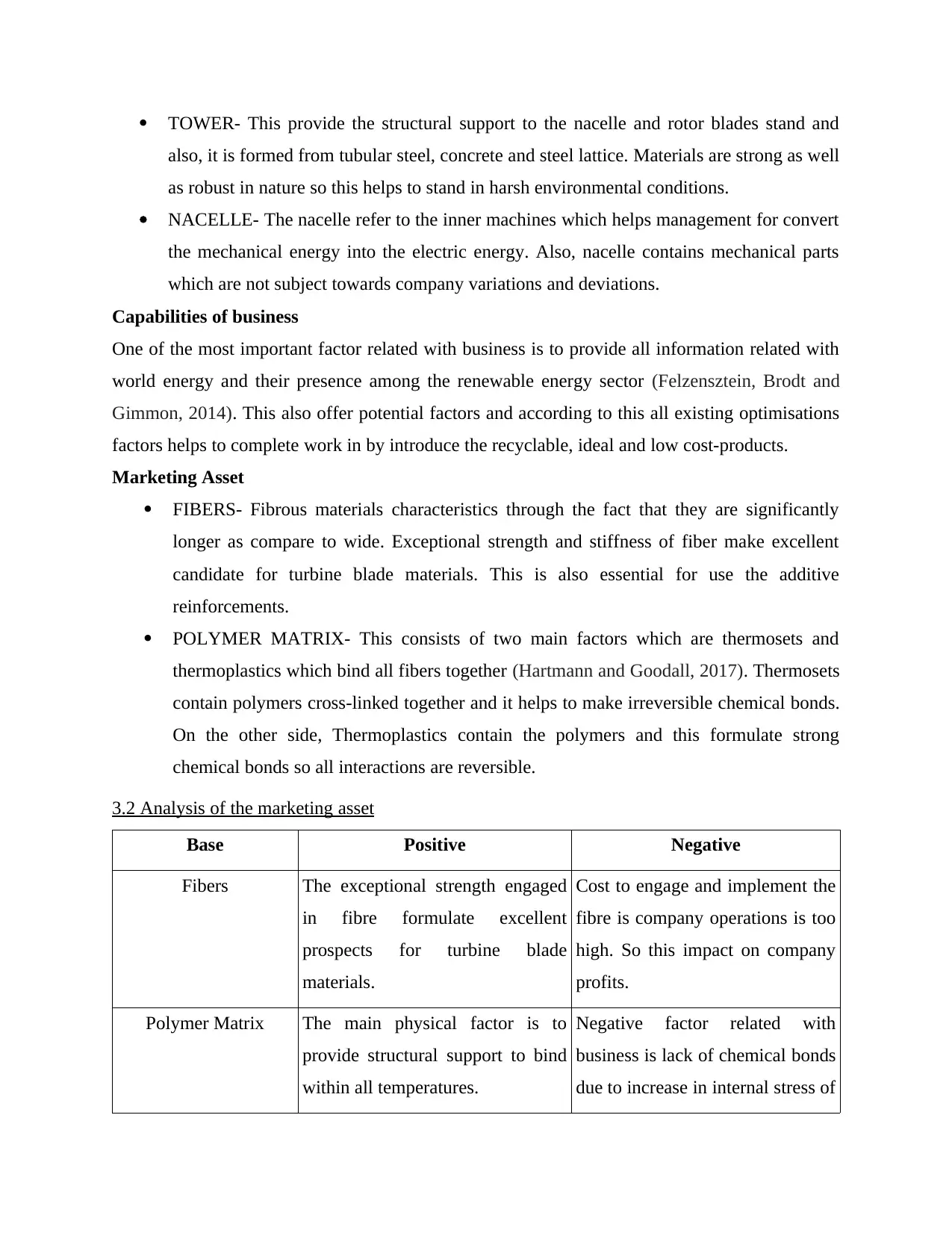
TOWER- This provide the structural support to the nacelle and rotor blades stand and
also, it is formed from tubular steel, concrete and steel lattice. Materials are strong as well
as robust in nature so this helps to stand in harsh environmental conditions.
NACELLE- The nacelle refer to the inner machines which helps management for convert
the mechanical energy into the electric energy. Also, nacelle contains mechanical parts
which are not subject towards company variations and deviations.
Capabilities of business
One of the most important factor related with business is to provide all information related with
world energy and their presence among the renewable energy sector (Felzensztein, Brodt and
Gimmon, 2014). This also offer potential factors and according to this all existing optimisations
factors helps to complete work in by introduce the recyclable, ideal and low cost-products.
Marketing Asset
FIBERS- Fibrous materials characteristics through the fact that they are significantly
longer as compare to wide. Exceptional strength and stiffness of fiber make excellent
candidate for turbine blade materials. This is also essential for use the additive
reinforcements.
POLYMER MATRIX- This consists of two main factors which are thermosets and
thermoplastics which bind all fibers together (Hartmann and Goodall, 2017). Thermosets
contain polymers cross-linked together and it helps to make irreversible chemical bonds.
On the other side, Thermoplastics contain the polymers and this formulate strong
chemical bonds so all interactions are reversible.
3.2 Analysis of the marketing asset
Base Positive Negative
Fibers The exceptional strength engaged
in fibre formulate excellent
prospects for turbine blade
materials.
Cost to engage and implement the
fibre is company operations is too
high. So this impact on company
profits.
Polymer Matrix The main physical factor is to
provide structural support to bind
within all temperatures.
Negative factor related with
business is lack of chemical bonds
due to increase in internal stress of
also, it is formed from tubular steel, concrete and steel lattice. Materials are strong as well
as robust in nature so this helps to stand in harsh environmental conditions.
NACELLE- The nacelle refer to the inner machines which helps management for convert
the mechanical energy into the electric energy. Also, nacelle contains mechanical parts
which are not subject towards company variations and deviations.
Capabilities of business
One of the most important factor related with business is to provide all information related with
world energy and their presence among the renewable energy sector (Felzensztein, Brodt and
Gimmon, 2014). This also offer potential factors and according to this all existing optimisations
factors helps to complete work in by introduce the recyclable, ideal and low cost-products.
Marketing Asset
FIBERS- Fibrous materials characteristics through the fact that they are significantly
longer as compare to wide. Exceptional strength and stiffness of fiber make excellent
candidate for turbine blade materials. This is also essential for use the additive
reinforcements.
POLYMER MATRIX- This consists of two main factors which are thermosets and
thermoplastics which bind all fibers together (Hartmann and Goodall, 2017). Thermosets
contain polymers cross-linked together and it helps to make irreversible chemical bonds.
On the other side, Thermoplastics contain the polymers and this formulate strong
chemical bonds so all interactions are reversible.
3.2 Analysis of the marketing asset
Base Positive Negative
Fibers The exceptional strength engaged
in fibre formulate excellent
prospects for turbine blade
materials.
Cost to engage and implement the
fibre is company operations is too
high. So this impact on company
profits.
Polymer Matrix The main physical factor is to
provide structural support to bind
within all temperatures.
Negative factor related with
business is lack of chemical bonds
due to increase in internal stress of
Paraphrase This Document
Need a fresh take? Get an instant paraphrase of this document with our AI Paraphraser
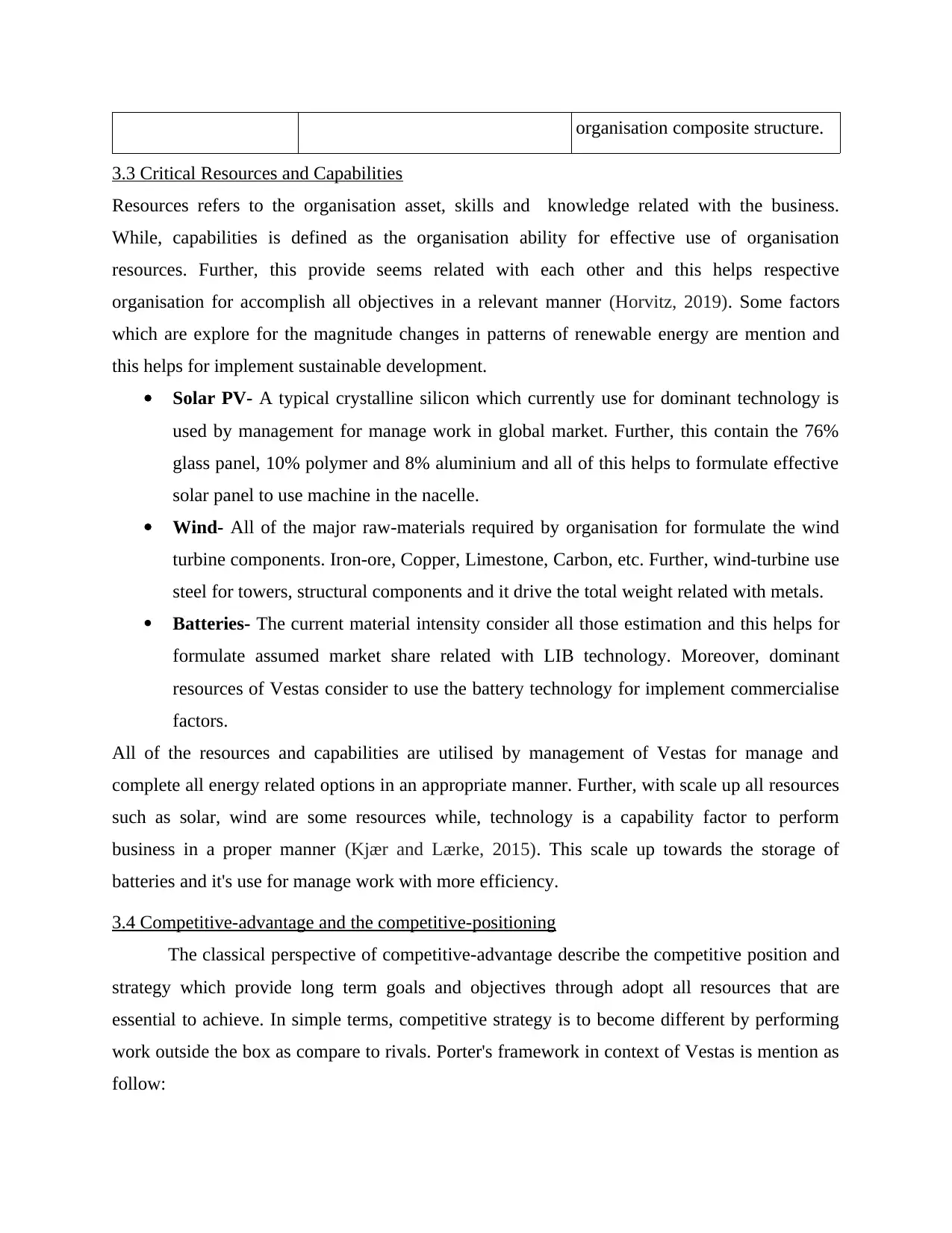
organisation composite structure.
3.3 Critical Resources and Capabilities
Resources refers to the organisation asset, skills and knowledge related with the business.
While, capabilities is defined as the organisation ability for effective use of organisation
resources. Further, this provide seems related with each other and this helps respective
organisation for accomplish all objectives in a relevant manner (Horvitz, 2019). Some factors
which are explore for the magnitude changes in patterns of renewable energy are mention and
this helps for implement sustainable development.
Solar PV- A typical crystalline silicon which currently use for dominant technology is
used by management for manage work in global market. Further, this contain the 76%
glass panel, 10% polymer and 8% aluminium and all of this helps to formulate effective
solar panel to use machine in the nacelle.
Wind- All of the major raw-materials required by organisation for formulate the wind
turbine components. Iron-ore, Copper, Limestone, Carbon, etc. Further, wind-turbine use
steel for towers, structural components and it drive the total weight related with metals.
Batteries- The current material intensity consider all those estimation and this helps for
formulate assumed market share related with LIB technology. Moreover, dominant
resources of Vestas consider to use the battery technology for implement commercialise
factors.
All of the resources and capabilities are utilised by management of Vestas for manage and
complete all energy related options in an appropriate manner. Further, with scale up all resources
such as solar, wind are some resources while, technology is a capability factor to perform
business in a proper manner (Kjær and Lærke, 2015). This scale up towards the storage of
batteries and it's use for manage work with more efficiency.
3.4 Competitive-advantage and the competitive-positioning
The classical perspective of competitive-advantage describe the competitive position and
strategy which provide long term goals and objectives through adopt all resources that are
essential to achieve. In simple terms, competitive strategy is to become different by performing
work outside the box as compare to rivals. Porter's framework in context of Vestas is mention as
follow:
3.3 Critical Resources and Capabilities
Resources refers to the organisation asset, skills and knowledge related with the business.
While, capabilities is defined as the organisation ability for effective use of organisation
resources. Further, this provide seems related with each other and this helps respective
organisation for accomplish all objectives in a relevant manner (Horvitz, 2019). Some factors
which are explore for the magnitude changes in patterns of renewable energy are mention and
this helps for implement sustainable development.
Solar PV- A typical crystalline silicon which currently use for dominant technology is
used by management for manage work in global market. Further, this contain the 76%
glass panel, 10% polymer and 8% aluminium and all of this helps to formulate effective
solar panel to use machine in the nacelle.
Wind- All of the major raw-materials required by organisation for formulate the wind
turbine components. Iron-ore, Copper, Limestone, Carbon, etc. Further, wind-turbine use
steel for towers, structural components and it drive the total weight related with metals.
Batteries- The current material intensity consider all those estimation and this helps for
formulate assumed market share related with LIB technology. Moreover, dominant
resources of Vestas consider to use the battery technology for implement commercialise
factors.
All of the resources and capabilities are utilised by management of Vestas for manage and
complete all energy related options in an appropriate manner. Further, with scale up all resources
such as solar, wind are some resources while, technology is a capability factor to perform
business in a proper manner (Kjær and Lærke, 2015). This scale up towards the storage of
batteries and it's use for manage work with more efficiency.
3.4 Competitive-advantage and the competitive-positioning
The classical perspective of competitive-advantage describe the competitive position and
strategy which provide long term goals and objectives through adopt all resources that are
essential to achieve. In simple terms, competitive strategy is to become different by performing
work outside the box as compare to rivals. Porter's framework in context of Vestas is mention as
follow:
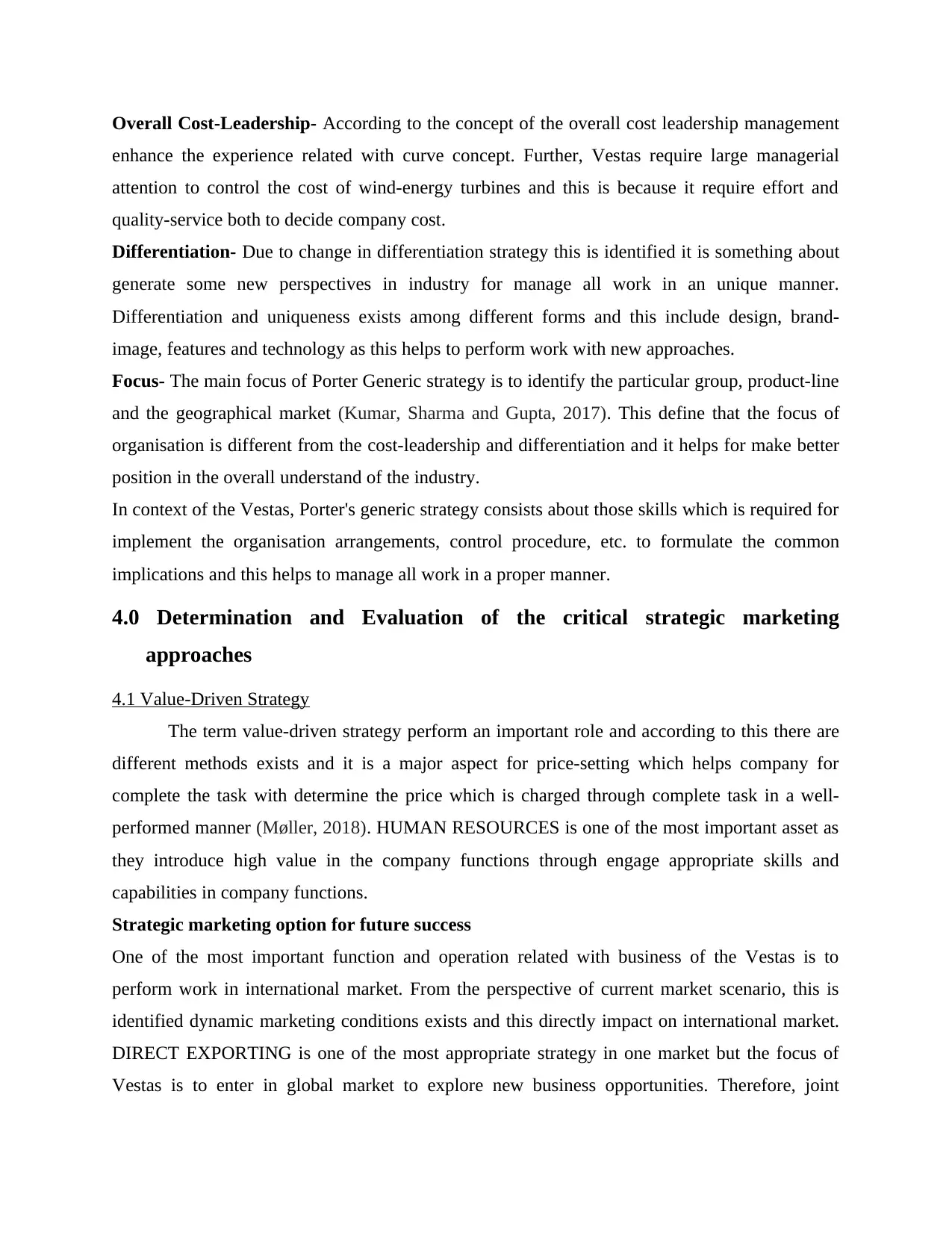
Overall Cost-Leadership- According to the concept of the overall cost leadership management
enhance the experience related with curve concept. Further, Vestas require large managerial
attention to control the cost of wind-energy turbines and this is because it require effort and
quality-service both to decide company cost.
Differentiation- Due to change in differentiation strategy this is identified it is something about
generate some new perspectives in industry for manage all work in an unique manner.
Differentiation and uniqueness exists among different forms and this include design, brand-
image, features and technology as this helps to perform work with new approaches.
Focus- The main focus of Porter Generic strategy is to identify the particular group, product-line
and the geographical market (Kumar, Sharma and Gupta, 2017). This define that the focus of
organisation is different from the cost-leadership and differentiation and it helps for make better
position in the overall understand of the industry.
In context of the Vestas, Porter's generic strategy consists about those skills which is required for
implement the organisation arrangements, control procedure, etc. to formulate the common
implications and this helps to manage all work in a proper manner.
4.0 Determination and Evaluation of the critical strategic marketing
approaches
4.1 Value-Driven Strategy
The term value-driven strategy perform an important role and according to this there are
different methods exists and it is a major aspect for price-setting which helps company for
complete the task with determine the price which is charged through complete task in a well-
performed manner (Møller, 2018). HUMAN RESOURCES is one of the most important asset as
they introduce high value in the company functions through engage appropriate skills and
capabilities in company functions.
Strategic marketing option for future success
One of the most important function and operation related with business of the Vestas is to
perform work in international market. From the perspective of current market scenario, this is
identified dynamic marketing conditions exists and this directly impact on international market.
DIRECT EXPORTING is one of the most appropriate strategy in one market but the focus of
Vestas is to enter in global market to explore new business opportunities. Therefore, joint
enhance the experience related with curve concept. Further, Vestas require large managerial
attention to control the cost of wind-energy turbines and this is because it require effort and
quality-service both to decide company cost.
Differentiation- Due to change in differentiation strategy this is identified it is something about
generate some new perspectives in industry for manage all work in an unique manner.
Differentiation and uniqueness exists among different forms and this include design, brand-
image, features and technology as this helps to perform work with new approaches.
Focus- The main focus of Porter Generic strategy is to identify the particular group, product-line
and the geographical market (Kumar, Sharma and Gupta, 2017). This define that the focus of
organisation is different from the cost-leadership and differentiation and it helps for make better
position in the overall understand of the industry.
In context of the Vestas, Porter's generic strategy consists about those skills which is required for
implement the organisation arrangements, control procedure, etc. to formulate the common
implications and this helps to manage all work in a proper manner.
4.0 Determination and Evaluation of the critical strategic marketing
approaches
4.1 Value-Driven Strategy
The term value-driven strategy perform an important role and according to this there are
different methods exists and it is a major aspect for price-setting which helps company for
complete the task with determine the price which is charged through complete task in a well-
performed manner (Møller, 2018). HUMAN RESOURCES is one of the most important asset as
they introduce high value in the company functions through engage appropriate skills and
capabilities in company functions.
Strategic marketing option for future success
One of the most important function and operation related with business of the Vestas is to
perform work in international market. From the perspective of current market scenario, this is
identified dynamic marketing conditions exists and this directly impact on international market.
DIRECT EXPORTING is one of the most appropriate strategy in one market but the focus of
Vestas is to enter in global market to explore new business opportunities. Therefore, joint
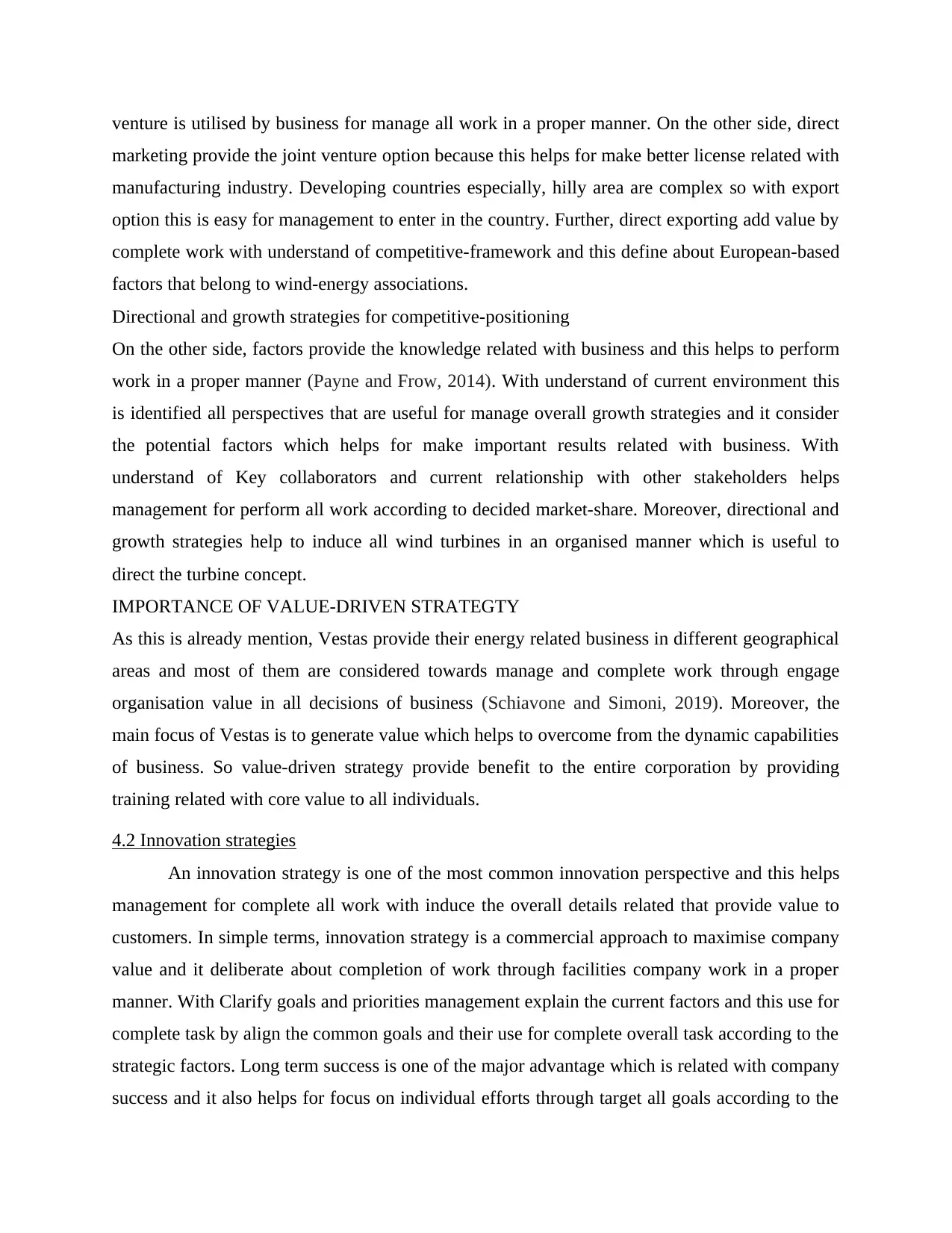
venture is utilised by business for manage all work in a proper manner. On the other side, direct
marketing provide the joint venture option because this helps for make better license related with
manufacturing industry. Developing countries especially, hilly area are complex so with export
option this is easy for management to enter in the country. Further, direct exporting add value by
complete work with understand of competitive-framework and this define about European-based
factors that belong to wind-energy associations.
Directional and growth strategies for competitive-positioning
On the other side, factors provide the knowledge related with business and this helps to perform
work in a proper manner (Payne and Frow, 2014). With understand of current environment this
is identified all perspectives that are useful for manage overall growth strategies and it consider
the potential factors which helps for make important results related with business. With
understand of Key collaborators and current relationship with other stakeholders helps
management for perform all work according to decided market-share. Moreover, directional and
growth strategies help to induce all wind turbines in an organised manner which is useful to
direct the turbine concept.
IMPORTANCE OF VALUE-DRIVEN STRATEGTY
As this is already mention, Vestas provide their energy related business in different geographical
areas and most of them are considered towards manage and complete work through engage
organisation value in all decisions of business (Schiavone and Simoni, 2019). Moreover, the
main focus of Vestas is to generate value which helps to overcome from the dynamic capabilities
of business. So value-driven strategy provide benefit to the entire corporation by providing
training related with core value to all individuals.
4.2 Innovation strategies
An innovation strategy is one of the most common innovation perspective and this helps
management for complete all work with induce the overall details related that provide value to
customers. In simple terms, innovation strategy is a commercial approach to maximise company
value and it deliberate about completion of work through facilities company work in a proper
manner. With Clarify goals and priorities management explain the current factors and this use for
complete task by align the common goals and their use for complete overall task according to the
strategic factors. Long term success is one of the major advantage which is related with company
success and it also helps for focus on individual efforts through target all goals according to the
marketing provide the joint venture option because this helps for make better license related with
manufacturing industry. Developing countries especially, hilly area are complex so with export
option this is easy for management to enter in the country. Further, direct exporting add value by
complete work with understand of competitive-framework and this define about European-based
factors that belong to wind-energy associations.
Directional and growth strategies for competitive-positioning
On the other side, factors provide the knowledge related with business and this helps to perform
work in a proper manner (Payne and Frow, 2014). With understand of current environment this
is identified all perspectives that are useful for manage overall growth strategies and it consider
the potential factors which helps for make important results related with business. With
understand of Key collaborators and current relationship with other stakeholders helps
management for perform all work according to decided market-share. Moreover, directional and
growth strategies help to induce all wind turbines in an organised manner which is useful to
direct the turbine concept.
IMPORTANCE OF VALUE-DRIVEN STRATEGTY
As this is already mention, Vestas provide their energy related business in different geographical
areas and most of them are considered towards manage and complete work through engage
organisation value in all decisions of business (Schiavone and Simoni, 2019). Moreover, the
main focus of Vestas is to generate value which helps to overcome from the dynamic capabilities
of business. So value-driven strategy provide benefit to the entire corporation by providing
training related with core value to all individuals.
4.2 Innovation strategies
An innovation strategy is one of the most common innovation perspective and this helps
management for complete all work with induce the overall details related that provide value to
customers. In simple terms, innovation strategy is a commercial approach to maximise company
value and it deliberate about completion of work through facilities company work in a proper
manner. With Clarify goals and priorities management explain the current factors and this use for
complete task by align the common goals and their use for complete overall task according to the
strategic factors. Long term success is one of the major advantage which is related with company
success and it also helps for focus on individual efforts through target all goals according to the
Secure Best Marks with AI Grader
Need help grading? Try our AI Grader for instant feedback on your assignments.
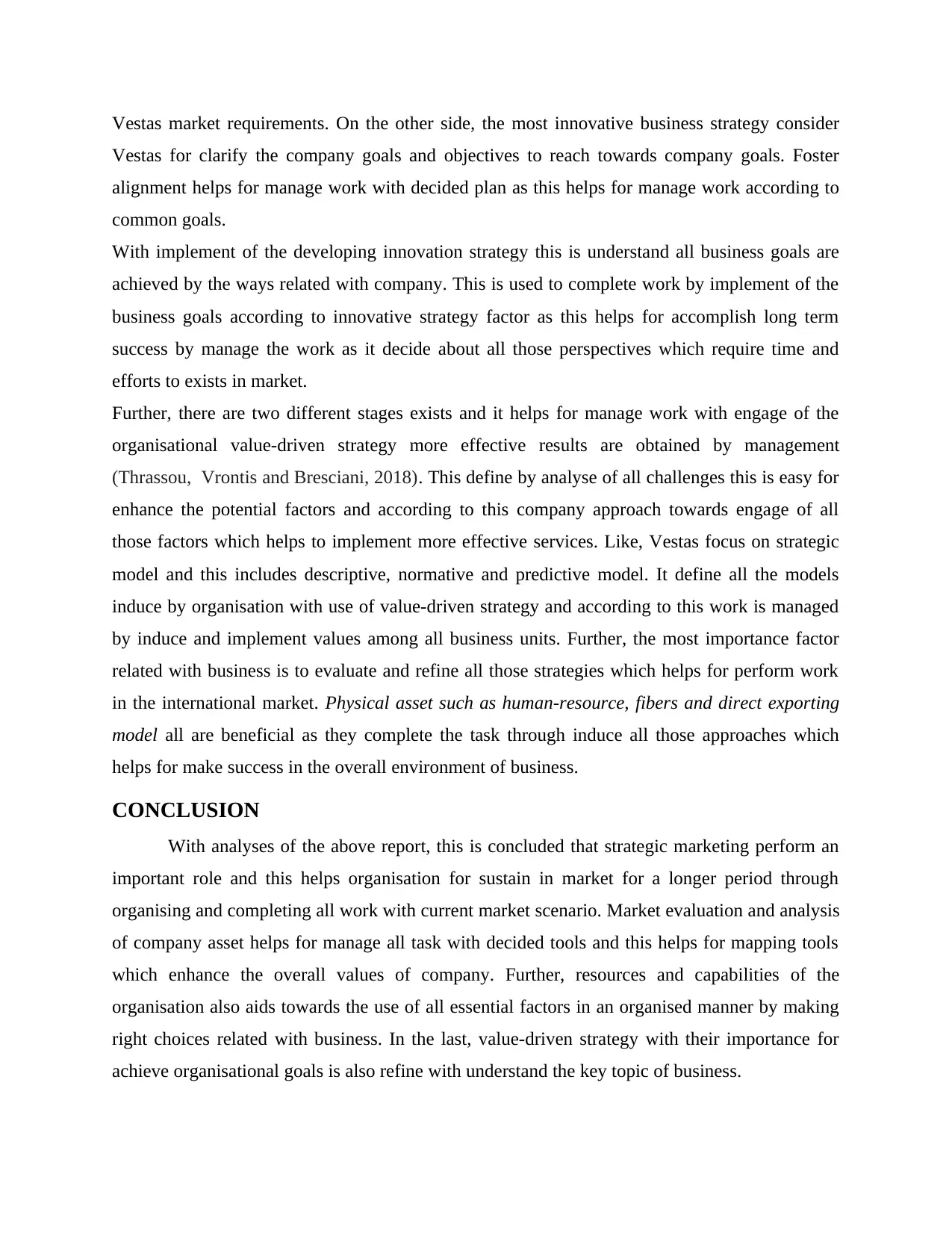
Vestas market requirements. On the other side, the most innovative business strategy consider
Vestas for clarify the company goals and objectives to reach towards company goals. Foster
alignment helps for manage work with decided plan as this helps for manage work according to
common goals.
With implement of the developing innovation strategy this is understand all business goals are
achieved by the ways related with company. This is used to complete work by implement of the
business goals according to innovative strategy factor as this helps for accomplish long term
success by manage the work as it decide about all those perspectives which require time and
efforts to exists in market.
Further, there are two different stages exists and it helps for manage work with engage of the
organisational value-driven strategy more effective results are obtained by management
(Thrassou, Vrontis and Bresciani, 2018). This define by analyse of all challenges this is easy for
enhance the potential factors and according to this company approach towards engage of all
those factors which helps to implement more effective services. Like, Vestas focus on strategic
model and this includes descriptive, normative and predictive model. It define all the models
induce by organisation with use of value-driven strategy and according to this work is managed
by induce and implement values among all business units. Further, the most importance factor
related with business is to evaluate and refine all those strategies which helps for perform work
in the international market. Physical asset such as human-resource, fibers and direct exporting
model all are beneficial as they complete the task through induce all those approaches which
helps for make success in the overall environment of business.
CONCLUSION
With analyses of the above report, this is concluded that strategic marketing perform an
important role and this helps organisation for sustain in market for a longer period through
organising and completing all work with current market scenario. Market evaluation and analysis
of company asset helps for manage all task with decided tools and this helps for mapping tools
which enhance the overall values of company. Further, resources and capabilities of the
organisation also aids towards the use of all essential factors in an organised manner by making
right choices related with business. In the last, value-driven strategy with their importance for
achieve organisational goals is also refine with understand the key topic of business.
Vestas for clarify the company goals and objectives to reach towards company goals. Foster
alignment helps for manage work with decided plan as this helps for manage work according to
common goals.
With implement of the developing innovation strategy this is understand all business goals are
achieved by the ways related with company. This is used to complete work by implement of the
business goals according to innovative strategy factor as this helps for accomplish long term
success by manage the work as it decide about all those perspectives which require time and
efforts to exists in market.
Further, there are two different stages exists and it helps for manage work with engage of the
organisational value-driven strategy more effective results are obtained by management
(Thrassou, Vrontis and Bresciani, 2018). This define by analyse of all challenges this is easy for
enhance the potential factors and according to this company approach towards engage of all
those factors which helps to implement more effective services. Like, Vestas focus on strategic
model and this includes descriptive, normative and predictive model. It define all the models
induce by organisation with use of value-driven strategy and according to this work is managed
by induce and implement values among all business units. Further, the most importance factor
related with business is to evaluate and refine all those strategies which helps for perform work
in the international market. Physical asset such as human-resource, fibers and direct exporting
model all are beneficial as they complete the task through induce all those approaches which
helps for make success in the overall environment of business.
CONCLUSION
With analyses of the above report, this is concluded that strategic marketing perform an
important role and this helps organisation for sustain in market for a longer period through
organising and completing all work with current market scenario. Market evaluation and analysis
of company asset helps for manage all task with decided tools and this helps for mapping tools
which enhance the overall values of company. Further, resources and capabilities of the
organisation also aids towards the use of all essential factors in an organised manner by making
right choices related with business. In the last, value-driven strategy with their importance for
achieve organisational goals is also refine with understand the key topic of business.

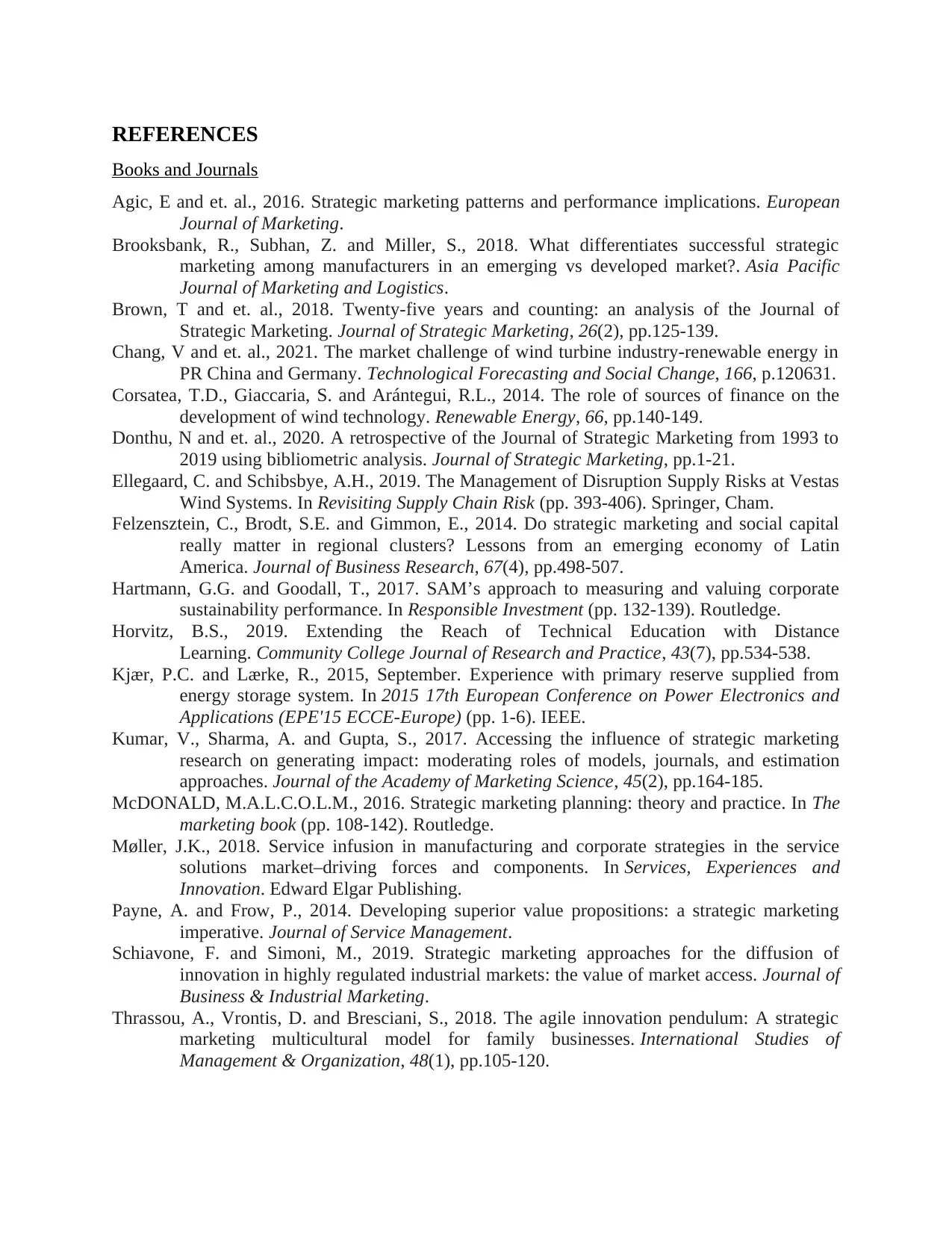
REFERENCES
Books and Journals
Agic, E and et. al., 2016. Strategic marketing patterns and performance implications. European
Journal of Marketing.
Brooksbank, R., Subhan, Z. and Miller, S., 2018. What differentiates successful strategic
marketing among manufacturers in an emerging vs developed market?. Asia Pacific
Journal of Marketing and Logistics.
Brown, T and et. al., 2018. Twenty-five years and counting: an analysis of the Journal of
Strategic Marketing. Journal of Strategic Marketing, 26(2), pp.125-139.
Chang, V and et. al., 2021. The market challenge of wind turbine industry-renewable energy in
PR China and Germany. Technological Forecasting and Social Change, 166, p.120631.
Corsatea, T.D., Giaccaria, S. and Arántegui, R.L., 2014. The role of sources of finance on the
development of wind technology. Renewable Energy, 66, pp.140-149.
Donthu, N and et. al., 2020. A retrospective of the Journal of Strategic Marketing from 1993 to
2019 using bibliometric analysis. Journal of Strategic Marketing, pp.1-21.
Ellegaard, C. and Schibsbye, A.H., 2019. The Management of Disruption Supply Risks at Vestas
Wind Systems. In Revisiting Supply Chain Risk (pp. 393-406). Springer, Cham.
Felzensztein, C., Brodt, S.E. and Gimmon, E., 2014. Do strategic marketing and social capital
really matter in regional clusters? Lessons from an emerging economy of Latin
America. Journal of Business Research, 67(4), pp.498-507.
Hartmann, G.G. and Goodall, T., 2017. SAM’s approach to measuring and valuing corporate
sustainability performance. In Responsible Investment (pp. 132-139). Routledge.
Horvitz, B.S., 2019. Extending the Reach of Technical Education with Distance
Learning. Community College Journal of Research and Practice, 43(7), pp.534-538.
Kjær, P.C. and Lærke, R., 2015, September. Experience with primary reserve supplied from
energy storage system. In 2015 17th European Conference on Power Electronics and
Applications (EPE'15 ECCE-Europe) (pp. 1-6). IEEE.
Kumar, V., Sharma, A. and Gupta, S., 2017. Accessing the influence of strategic marketing
research on generating impact: moderating roles of models, journals, and estimation
approaches. Journal of the Academy of Marketing Science, 45(2), pp.164-185.
McDONALD, M.A.L.C.O.L.M., 2016. Strategic marketing planning: theory and practice. In The
marketing book (pp. 108-142). Routledge.
Møller, J.K., 2018. Service infusion in manufacturing and corporate strategies in the service
solutions market–driving forces and components. In Services, Experiences and
Innovation. Edward Elgar Publishing.
Payne, A. and Frow, P., 2014. Developing superior value propositions: a strategic marketing
imperative. Journal of Service Management.
Schiavone, F. and Simoni, M., 2019. Strategic marketing approaches for the diffusion of
innovation in highly regulated industrial markets: the value of market access. Journal of
Business & Industrial Marketing.
Thrassou, A., Vrontis, D. and Bresciani, S., 2018. The agile innovation pendulum: A strategic
marketing multicultural model for family businesses. International Studies of
Management & Organization, 48(1), pp.105-120.
Books and Journals
Agic, E and et. al., 2016. Strategic marketing patterns and performance implications. European
Journal of Marketing.
Brooksbank, R., Subhan, Z. and Miller, S., 2018. What differentiates successful strategic
marketing among manufacturers in an emerging vs developed market?. Asia Pacific
Journal of Marketing and Logistics.
Brown, T and et. al., 2018. Twenty-five years and counting: an analysis of the Journal of
Strategic Marketing. Journal of Strategic Marketing, 26(2), pp.125-139.
Chang, V and et. al., 2021. The market challenge of wind turbine industry-renewable energy in
PR China and Germany. Technological Forecasting and Social Change, 166, p.120631.
Corsatea, T.D., Giaccaria, S. and Arántegui, R.L., 2014. The role of sources of finance on the
development of wind technology. Renewable Energy, 66, pp.140-149.
Donthu, N and et. al., 2020. A retrospective of the Journal of Strategic Marketing from 1993 to
2019 using bibliometric analysis. Journal of Strategic Marketing, pp.1-21.
Ellegaard, C. and Schibsbye, A.H., 2019. The Management of Disruption Supply Risks at Vestas
Wind Systems. In Revisiting Supply Chain Risk (pp. 393-406). Springer, Cham.
Felzensztein, C., Brodt, S.E. and Gimmon, E., 2014. Do strategic marketing and social capital
really matter in regional clusters? Lessons from an emerging economy of Latin
America. Journal of Business Research, 67(4), pp.498-507.
Hartmann, G.G. and Goodall, T., 2017. SAM’s approach to measuring and valuing corporate
sustainability performance. In Responsible Investment (pp. 132-139). Routledge.
Horvitz, B.S., 2019. Extending the Reach of Technical Education with Distance
Learning. Community College Journal of Research and Practice, 43(7), pp.534-538.
Kjær, P.C. and Lærke, R., 2015, September. Experience with primary reserve supplied from
energy storage system. In 2015 17th European Conference on Power Electronics and
Applications (EPE'15 ECCE-Europe) (pp. 1-6). IEEE.
Kumar, V., Sharma, A. and Gupta, S., 2017. Accessing the influence of strategic marketing
research on generating impact: moderating roles of models, journals, and estimation
approaches. Journal of the Academy of Marketing Science, 45(2), pp.164-185.
McDONALD, M.A.L.C.O.L.M., 2016. Strategic marketing planning: theory and practice. In The
marketing book (pp. 108-142). Routledge.
Møller, J.K., 2018. Service infusion in manufacturing and corporate strategies in the service
solutions market–driving forces and components. In Services, Experiences and
Innovation. Edward Elgar Publishing.
Payne, A. and Frow, P., 2014. Developing superior value propositions: a strategic marketing
imperative. Journal of Service Management.
Schiavone, F. and Simoni, M., 2019. Strategic marketing approaches for the diffusion of
innovation in highly regulated industrial markets: the value of market access. Journal of
Business & Industrial Marketing.
Thrassou, A., Vrontis, D. and Bresciani, S., 2018. The agile innovation pendulum: A strategic
marketing multicultural model for family businesses. International Studies of
Management & Organization, 48(1), pp.105-120.
Paraphrase This Document
Need a fresh take? Get an instant paraphrase of this document with our AI Paraphraser
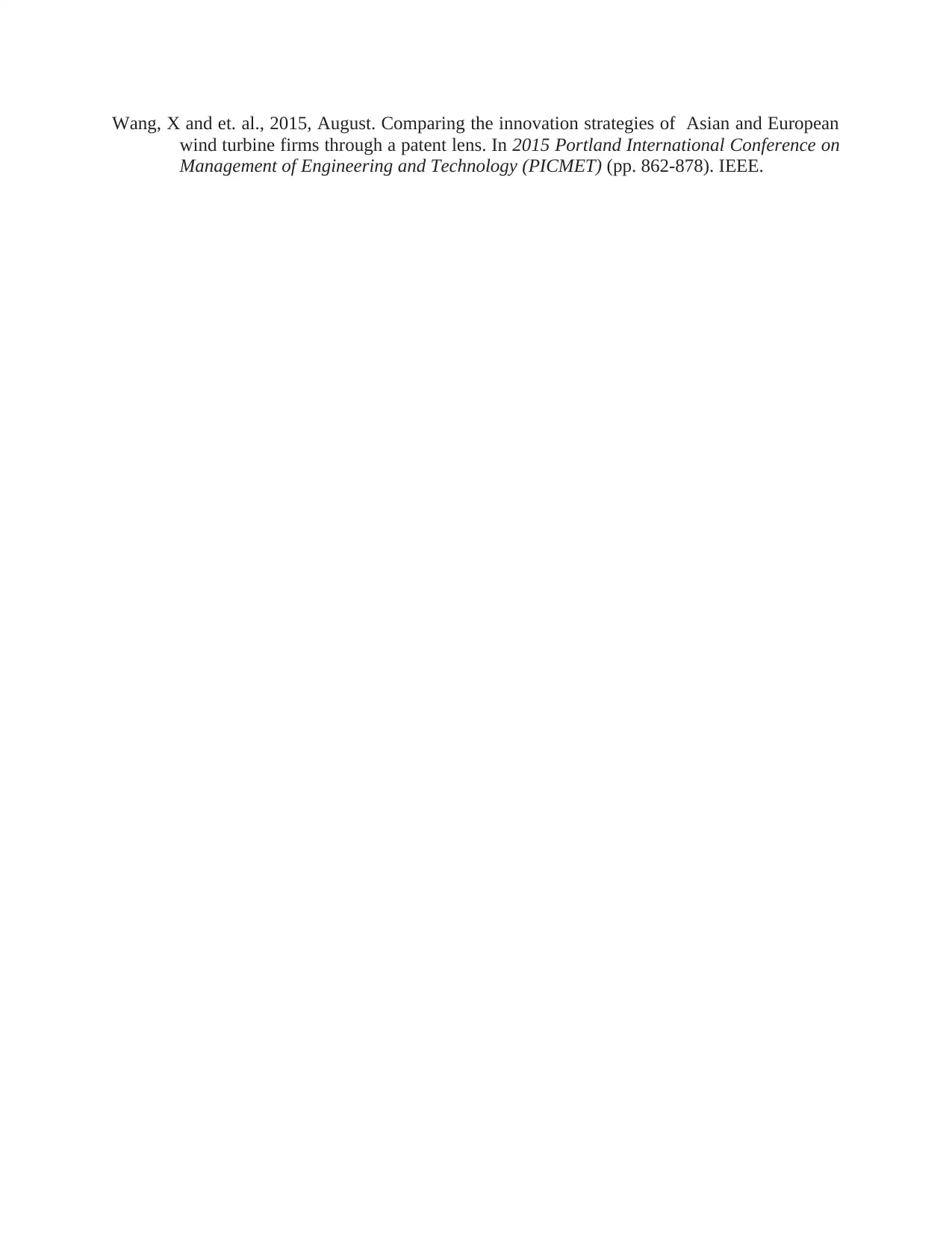
Wang, X and et. al., 2015, August. Comparing the innovation strategies of Asian and European
wind turbine firms through a patent lens. In 2015 Portland International Conference on
Management of Engineering and Technology (PICMET) (pp. 862-878). IEEE.
wind turbine firms through a patent lens. In 2015 Portland International Conference on
Management of Engineering and Technology (PICMET) (pp. 862-878). IEEE.

1 out of 15
Related Documents
Your All-in-One AI-Powered Toolkit for Academic Success.
+13062052269
info@desklib.com
Available 24*7 on WhatsApp / Email
![[object Object]](/_next/static/media/star-bottom.7253800d.svg)
Unlock your academic potential
© 2024 | Zucol Services PVT LTD | All rights reserved.





